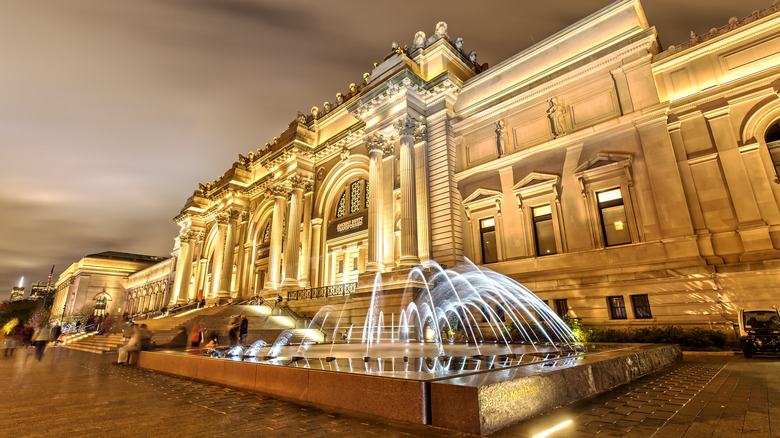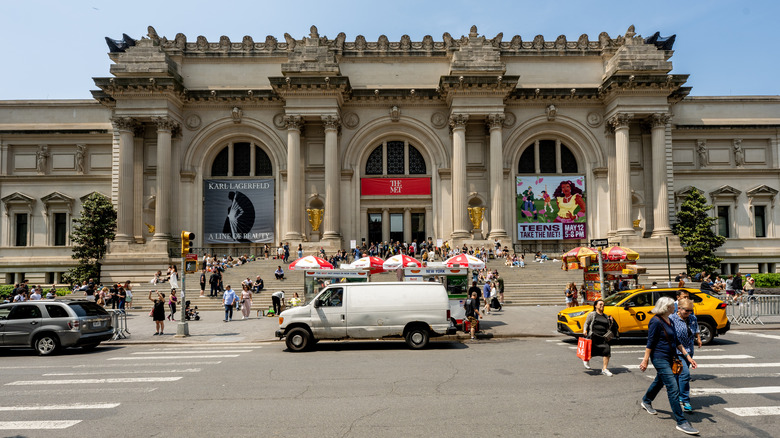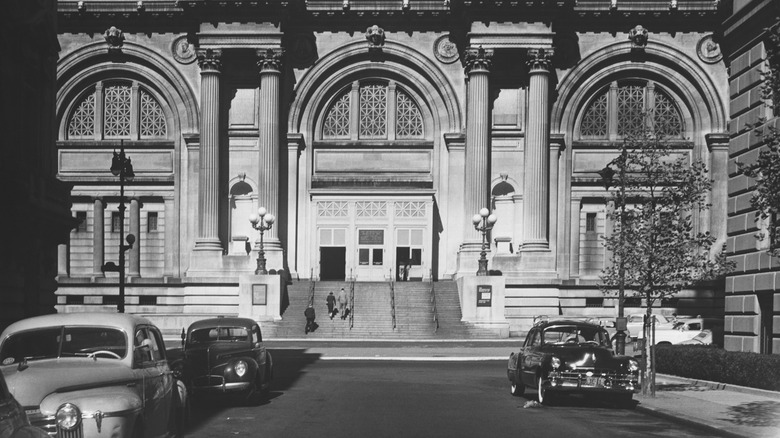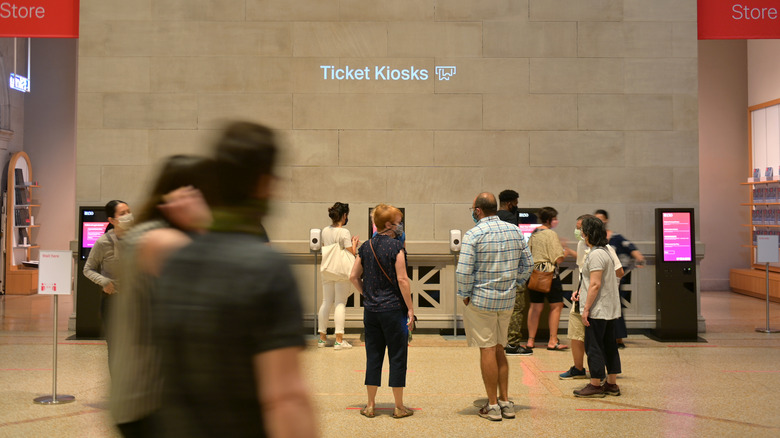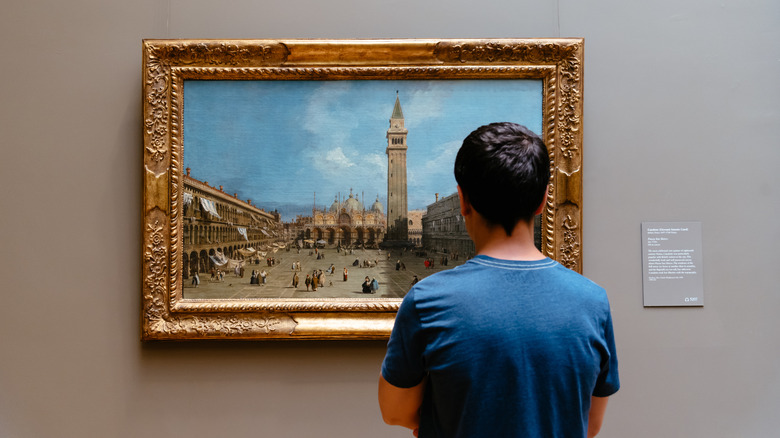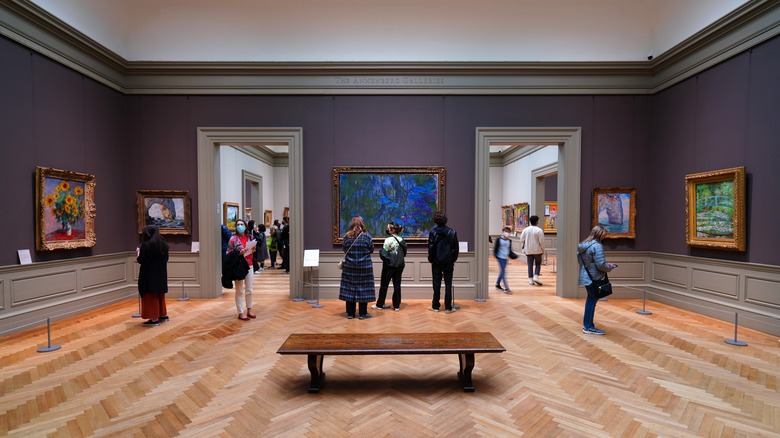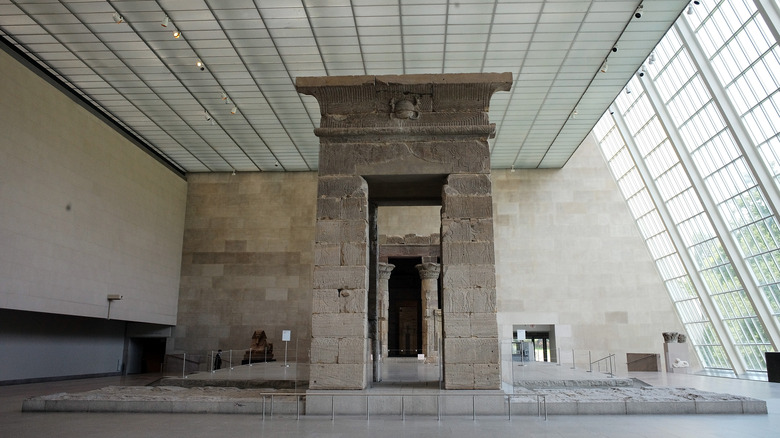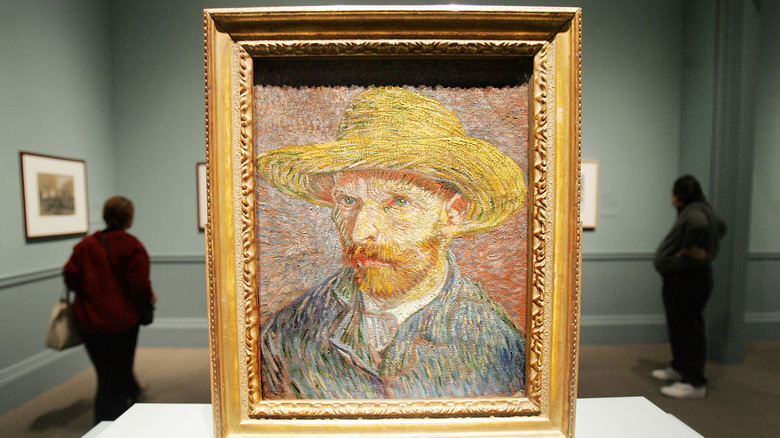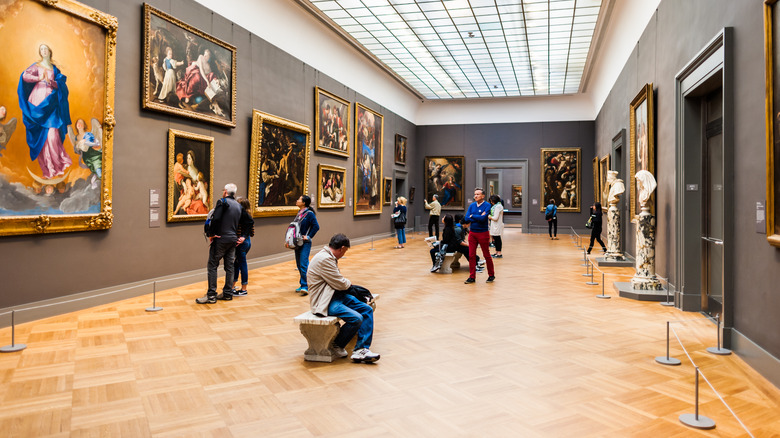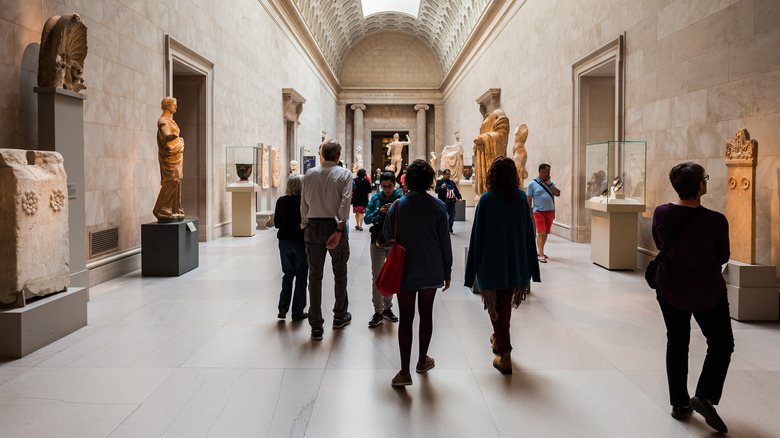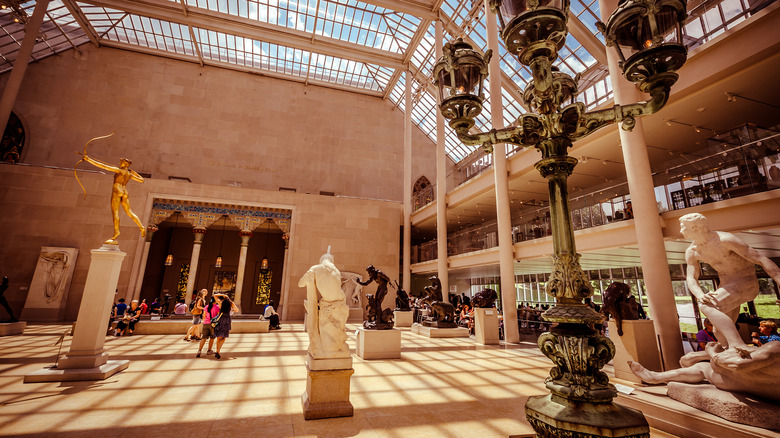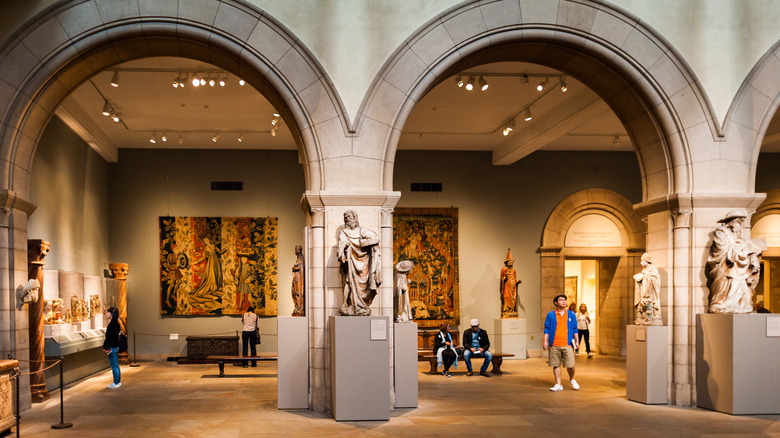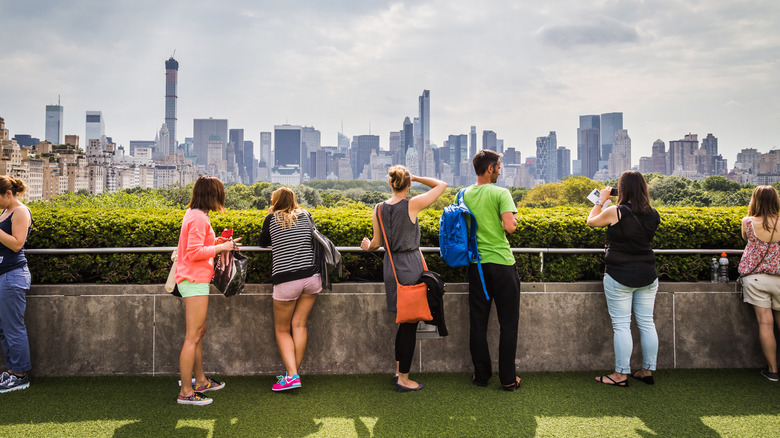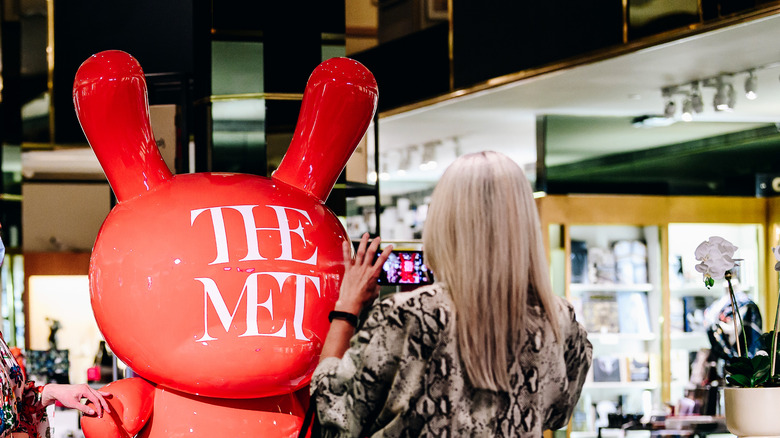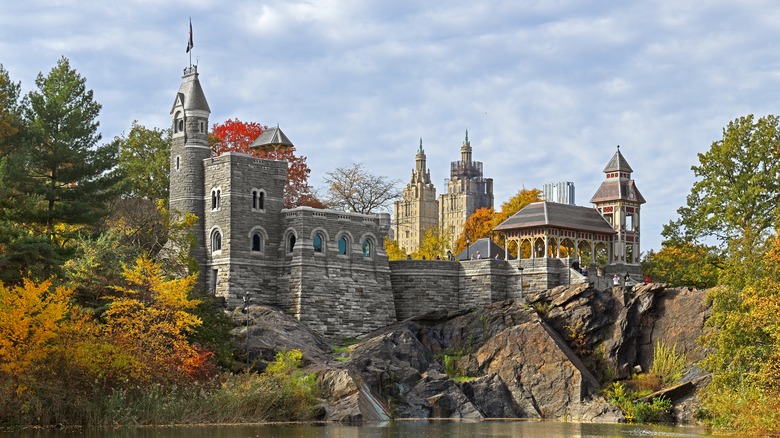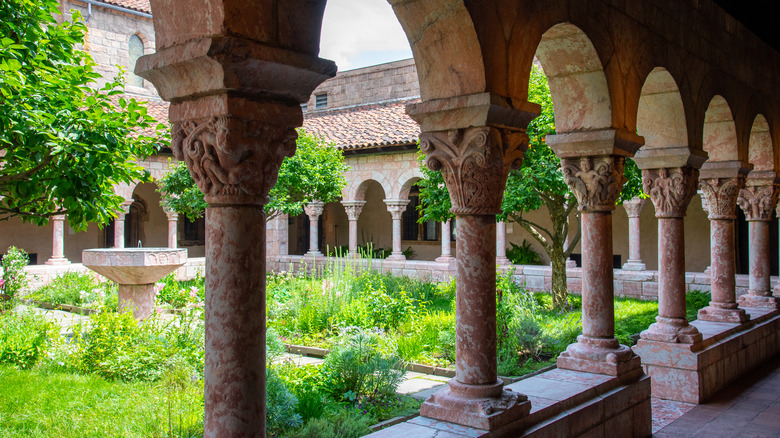A Local's Guide To Making The Most Out Of Your Day At The Met In NYC
For fans of visiting museums, can any city in the United States compare to New York City? Just look at the number of them here, spread across the five boroughs, from the Alice Austen House Museum in Staten Island to the Van Cortlandt House Museum in The Bronx. The choices are mind-boggling, with museums that are dedicated to modern art, Jewish heritage, design, the culture of Puerto Rico, natural history, and so much more. And yet, for all the variety, the rich vein of cultural enrichment, one institution stands out.
The Metropolitan Museum of Art, typically shortened to the Met, is the standard bearer for NYC museums, a colossal warren of collections that spans continents and eras, which is why visitors will find both antiquities and modern works, and pretty much anything else in between. But all those goodies, all that delectable art, can be a little overwhelming, and patrons might find themselves paralyzed by the sheer volume of what's on offer. That is why it is critical to plan a visit ahead of time, to have a sense of what to expect, where to go, and what to see. Otherwise, you might just find yourself wandering aimlessly and missing the parts of the museum that would be at the top of your list if you'd just done a little homework beforehand.
The prep
Sitting on a plum stretch of Fifth Avenue, right by Central Park, the museum really is cinematically positioned. This is a part of the city that you might see in a movie or high-flying streaming series, where a titan of commerce steps out of her doorman-attended building into a shiny limousine, en route to a meeting where the fate of her global empire hangs in the balance. The easiest way to get to the Met is by subway on the 4, 5, and 6 trains (green lines), or the Q train (yellow line) to 86th Street, and from either it's a short walk west to the museum, which fills Fifth Avenue between East 80th and East 84th Street.
For the bus, routes M1, M2, M3, and M4 are the best options — stop at Fifth Avenue and East 84th Street going south, or Madison Avenue and East 83rd Street heading north. There are also CitiBike docks near the Met. If you plan to spend the entire day here — and, to be honest, you'll need that much time, but even then, you'll only scratch the surface — pack smartly and lightly. You can only bring in water, no other food or drink, and backpacks need to be small and worn on the side or in front of you. Consider packing a light sweater or jacket in the summer, because the climate-controlled galleries can feel a little chilly after being outside in the soupy, humid air.
The background
While the Met is New York through and through, it's strange to think that the idea of this institution first germinated in Paris. In the 1860s, Americans living in the French capital discussed and cemented the idea of a cultural repository of art for their compatriots back home. Soon, a team of politicians, city leaders, people in the art world, and local corporate executives rallied together and in April 1870, the museum was formalized, opening on Fifth Avenue but further south from its current site.
The museum's very first item was a coffin from Roman times, and slowly its collection grew, adding European artworks, and, within a decade, the Met relocated to the location that it now calls home. As time passed, so the stock of art the museum amassed grew, as did its footprint, adding halls and wings, and works by Old Masters. The rich history of this grand institution is really quite fitting, mirroring the art within it that epically retells mankind's travel through time.
The particulars
All that abundance comes at a price, and entry to the Met is $30 for adults, less for seniors or students, and free for children less than 12. It might seem like a steep fee, but it really isn't if you consider what you are getting, all for the price you'll usually pay for a movie at a multiplex and some snacks. Residents of New York might feel like they won the lottery, because they can pay whatever they want to get in, while students in the tri-state area — Connecticut, New Jersey, New York — are also eligible for this perk.
The museum opens from 10 a.m. to 5 p.m. every day except Wednesday when it is closed (take note), with hours on Friday and Saturday traveling a little further, up to 9 p.m. Certain special exhibitions, like the recent "Karl Lagerfeld: A Line of Beauty," have extended hours, in this case, up to 9 p.m. on Sundays, when the rest of the museum is closed. Visitors should always keep an eye out for this type of additional, one-off access, as it might suddenly make a trip to the museum on that day all the more attractive.
The no-nos
Spend any time in New York and you might think that it accepts pets the same way as it does people. Visitors will see them snuggled by the feet, or curled on the lap, of their owners in the subway, calmly trotting round stores on a leash as their parents wander along the aisles with them, or quietly waiting by an outdoor table while their guardians eat. Clearly, much of New York is pet friendly, but the Met is not. The only creatures allowed into the museum are service animals. Only small backpacks are allowed into the institution, larger ones will have to be checked, and for special exhibitions like the Lagerfeld one mentioned earlier, backpacks of any size are completely prohibited.
If you bring in a water bottle, make sure it's not made of glass, and only fill it with water — other drinks and all food are banned. While it might seem obvious, the art shouldn't be touched in any way or form, and if you really want a memento of something that you like, take a photo, which is allowed unless there are signs expressly forbidding it. While a museum isn't a library, and people are free to discuss and joust about how a piece of art makes them feel, visitors should remember that they are in a public place where reflection and contemplation are part of the experience, so they should keep their voices down, and their cellphone ringers off.
The layout
A Neoclassical beauty, the museum has really grown over the decades, with a rash of wings added between 1971 and 1991, and new galleries folded into the building as recently as 2012. The Met spreads over five floors and a mezzanine, and when viewed from above, looks a little like a boxy turtle, with the Robert Lehman Collection as the angular head. The vast bulk of exhibits are on the first and second floors, with the upper floors open for dining, drinking, and a comfortable lounge for donors that give $1,500 or more per year to the museum.
There's no obvious logic as to how the exhibitions are arranged, though American art is found in the building's northwest corner, and contemporary works tend to be in the southwest section. For history buffs, the first floor is where they will want to spend the lion's share of their time, with Greek and Roman Art, ancient Egypt, and Medieval Art all represented.
The showstopper
At every museum, there is that one exhibit that can't be missed, the headline performer. At the Louvre, it's the Mona Lisa, head to Florence's Academia Gallery and you would have to seek out Michelangelo's statue of David. At the Met, the apogee is the Temple of Dendur, in Gallery 131, on the first floor. More than 2,000 years old, this Egyptian shrine is filled with luminous details that belie the exhibit's age. The bottom of the temple features intricate carvings of papyrus and water lotus, plants that would have grown in the Nile at the time. Other imagery points to the importance of the sky in relation to Earth in Egyptian mythology, from the wings of Horus to representations of vultures.
Deities recur, which is why visitors will be able to make out Isis and Osiris (husband and wife deities, and parents to Horus), their heads topped with crowns. The temple is divided into sections, or rooms, each serving a different purpose, including prayer and ceremony. Standing in front of this exhibit, it's truly astounding to think that this building sat thousands of miles away, thousands of years ago, as a working shrine that drew devotees on a daily basis for ardent prayer, while today drawing visitors on account of its artistic wonder.
The other highlights
A visit to the Met is unlikely to be filled with moments of boredom, such is the wealth of objects to see and admire. The greater issue is likely to be that once you step through the front doors and into the Great Hall, and have a look around, you'll be overawed by the variety and span of the collection. It makes sense for visitors to try to focus on a few specific sections, based on their interests, though even then, there are certain pieces on display that really are world-class, and should definitely be included when wandering around the building. The Dutch painter Johannes Vermeer was alive during the 17th century, and is perhaps most well-known for his work "Girl with a Pearl Earring." It is believed that the Dutch Master only produced 34 paintings, and the Met has five of them in its collection, quite a coup.
A contemporary of Vermeer during the Golden Age, Rembrandt van Rijn, more commonly known by his first name, is also on display at the Met, including a self-portrait in Gallery 964 showing his ruddy cheeks and lined forehead. Another iconic Dutch work is by the luminary Vincent Van Gogh; his "Self-Portrait with a Straw Hat," a piece in Gallery 825, is both bright and energetic, as well as moody and soulful, a masterpiece of textural brushstrokes.
The fun
Despite all the highbrow, revered artwork that hangs on walls and stands in grand spaces around the Met, a visit here doesn't have to be about iconic painters and timeless historical artifacts. There are also some parts of the museum that are a little off-kilter, providing visitors with an experience that is both unexpected and downright whimsical, with places that will equally fascinate kids and inquisitive adults.
The Henry R. Luce Center for the Study of American Art, located in the American Wing, is like a beautifully maintained and curated antique shop, or the perfectly preserved contents from the estate sale of a lauded magnate. Items are arranged in glass cabinets lined neatly in rows and include furniture, sculptures, ceramics, and ornate metalwork. Visitors might find aged urns close to delicate crystal bowls or large portraits, such is the eclectic mix of objects. Kids will get a kick out of the Arms and Armor section, on the first floor, where soldier's protective layers and weapons from the Americas, Asia, and Europe, some dating more than 500 years, are on display. Museum-goers can find armor made for Henry II, the King of France, guns that belonged to Louis XIII, and pistols decorated by Tiffany and Company. The breadth of historical arms and armor exhibits from Asia is equally impressive, with a huge trove of pieces from Japan.
The unsung
You don't have to be deeply grounded in faith to appreciate the stunning pieces of religious art dotted around the museum. These are works that stand out not just for their ornate workmanship, but also their longevity, with some pieces dating further back than 1,000 B.C., like a piece in the Egyptian Art section showing Isis with Horus, the colors on her crown amazingly vibrant. It isn't hard to appreciate the glimmering medallion of Saint Peter, donated to the land of Georgia in Europe, and part of a larger set, with fine detailing of the saint holding a scepter.
Elsewhere you will find earnest portraits of sufis, miniature paintings from India, Egyptian jewelry that hung in temples, Buddhist statues from Nepal, a calendar page used in the church from 13th-century Britain, and Gothic chalices used in religious ceremonies in Southern Europe. There is a treasure chest of Islamic art at the Met, and even a part of a Jain prayer hall from northwest India, dating to the late 16th century.
The building
In the case of the Met, you can judge a book by its cover, since the fantastic contents inside are matched by the building and public areas, masterstrokes unto themselves. The plaza in front of the entrance was overhauled less than a decade ago, adding greenery, fountains, better lighting, and seating for people waiting or in need of a break. The facade prepares visitors for the majesty of the experience, made of limestone and punctuated by soaring arches and sturdy, thick columns atop a broad staircase. The sense of grandeur is matched in the Great Hall, right behind the entrance, where domes, columns, and arches bring pomp to the interiors. The upper level of the hall features a wraparound balcony, adding a theatrical component to the space.
The courtyard of the American Wing is a public area that brings an airy quality into the section, but it's also a beautiful arena for sculptures, and almost feels like an interior garden, with pieces of metalwork, glass, and ceramics on the balconies around it. And the Carroll and Milton Petrie European Sculpture Court recreates the sensibilities of a palatial spread on the Continent, with sturdy sculptures dotted around an area that was the original entrance to the museum, its access via a curling driveway in Central Park (visitors came by carriage right to the door), not the Fifth Avenue entryway used today.
The pacing
There really is too much to see here in a day, even if you only looked at every item for two seconds — and that would do the place a huge disservice — so it's important to pick your battles wisely. This place, after all, has 2 million square foot of space, or the equivalent of more than 34 American Football fields. That is a lot of ground to cover just in terms of walking, and factor in the viewing time, the movement from one part of the museum to the other, the bottlenecks and lines, and suddenly the equation gets a whole lot more complicated. Make sure to wear comfortable, broken-in shoes; don't wander around the halls in the flip-flops you're wearing because it's the height of summer, because you will be spending a lot of time on your feet.
Some galleries have places to sit, but many don't, and if you won't be able to last multiple hours here, consider just spending the morning or afternoon inside (with your breakfast or lunch, respectively, providing fuel to keep you going) and sharply focusing on what you want to see. Crowds are inevitable, but if you want to experience the place when they aren't so overpowering, arrive right at opening time, and head for the highlight pieces right at the start. Take breaks along the way, for a bite to eat or something to drink, or just to get some fresh air outside, the Met allows visitors re-entry.
The meal
There are a few places to eat and drink here, with most of them casual in their ambiance and menu. Classic diner-style dishes like burgers, sandwiches, salads, as well as pizzas, are on offer at the Eatery, on the main floor of the museum. You can get a great view of the Charles Engelhard Court from the American Wing Cafe, a good place to get a jolt of caffeine when the energy levels are flagging, and admire the sculptures of the courtyard right there, illuminated by natural light streaming through the glass ceiling.
A cafe near the Petrie Court and a lounge on the second floor offers more alternatives, while the most sophisticated dining is at the Met Dining Room, on the fourth floor. It features a seasonal menu and is run by beloved local chef Bill Telepan. For a breath of fresh air, literally, head to the Cantor Roof Garden Bar, on the top floor, and open until 8 p.m. on Fridays and Saturdays, for outdoor drinks that come with striking Central Park views.
The gifts
It would be a shame to visit this institution without purchasing a little something so you can take the experience home, and the Met, much like other museums, has a gift shop, the Met Store, on the second floor and next to the Balcony Lounge restaurant. While some items are available as standard, others are timed for specific exhibitions; at press time, the store was selling a number of goods to celebrate the Karl Lagerfeld exhibition, and these included a canvas shopping bag with an animated image of him on it, a keychain, water bottle, coaster set, and even leather doll in honor of the show.
A number of pieces at the store are perennial favorites, like scarves that have floral or geometric patterns, or representations of works that hang in the galleries of the museum. Coffee-table books on specific exhibitions are a way to funnel the subjects explored by the Met into your daily life, as are painting-by-numbers kits. Kids, one group always clamoring for something from the gift shop, will go gaga over the plush toys, puzzles of some of the artworks here, and a special, Met edition Monopoly set.
The surroundings
The Met sits in the Upper East Side, one of the swishest neighborhoods in the city, and backs right onto Central Park, so it's a great option for visitors that want to combine some outdoor exploration with some cultural stimulation. The neighborhood itself is called the Upper East Side, with some of the most esteemed private schools situated here, and in the Top 20 priciest city neighborhoods, with stately townhouses mixing with towering apartment buildings. There is plenty to see and do here — including the fabulous Solomon R. Guggenheim Museum less than a 10-minute walk away (though reserve a visit for another day) — for times when your brain needs a break from all that culture, and your legs grow wearing of supporting you.
A couple of luxury hotels are close by, The Mark and The Carlyle, and visitors in search of a plush lunch or a soothing tipple can drop by. One block over from Fifth Avenue, Madison Avenue is a prime shopping strip, with haute clothing, fashion, jewelry, and dining galore. A short walk from the museum, Belvedere Castle in Central Park is a flight of fancy that's a great subject to photograph, a mansion in miniature set above piles of rocks.
The alternates
There is another part of the Met, much further north in Manhattan, called the Met Cloisters, and entry to the main Met also includes same-day admission to the Cloisters (and vice-versa). There's a real air of quietude and contemplation at the Cloisters, where art from the Middle Ages is the prime focus. The layout of the space is anchored by a series of courtyards with walkways around them, and the idea for this scheme was generated by the sculptor George Grey Barnard, who used it to showcase his personal trove of medieval works. The space was later purchased by the Met, with financial assistance from businessman John D. Rockefeller, who also gave the museum some of his own medieval art to display.
In time, there was a need for a larger exhibiting space, and land nearby was purchased and turned into a park surrounding the institution, which slowly took shape as a facsimile of a medieval monastery. Now, this sumptuous destination feels like it has traveled through time and continents, and is home to ancient tapestries, historical prayer books that belonged to royalty, stained glass from European chapels, and so much more — as if visitors needed to grow their checklist of things to do at the Met!
